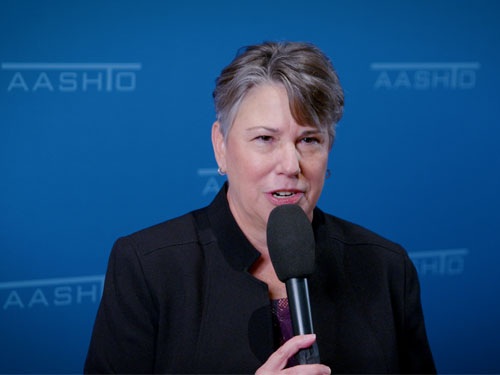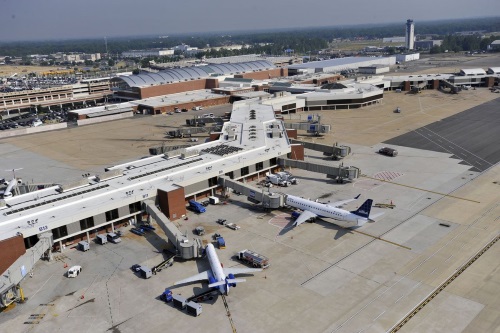Committee leaders in the House of Representatives and Senate Committee hammered out a final reconciliation on reauthorization legislation for the Federal Aviation Administration; a bill that includes reauthorizations and reforms of the Transportation Security Administration and the National Transportation Safety Board, while overhauling federal disaster programs.
[Above photo courtesy of Richmond International Airport]
The FAA bill’s amended text, filed in the House as H.R. 302, passed by a vote of 398 to 23. The House also passed an FAA extension bill dubbed H.R. 6897 that funds the agency through Oct. 7 in case the Senate does not vote on the legislation before fiscal year 2018 funding expires on Sept. 30.
“The FAA needs the long-term certainty provided by this bipartisan agreement, and America’s airport infrastructure, air travelers, and innovators across our aerospace industry will benefit from these improvements,” noted House Transportation and Infrastructure Committee Chairman Bill Shuster, R-Penn., in a statement. “In addition, this agreement will provide the most comprehensive disaster program reform since the post-Katrina law.”

In remarks Shuster made Sept. 24 at AASHTO’s annual meeting, he described the legislation as a “compromise FAA bill” that will push up airport investment dollars by $1 billion a year and thereby help improve “American competitiveness.” Shuster added that the bill will also integrate unmanned aerial vehicles or UAVs – more commonly called “drones” – more formally into the U.S. air space system.
“They are here, they are coming, and we need to figure out how to manage our air space with them in it,” he said.
The reconciled legislative package – which includes the FAA Reauthorization Act of 2018, the Disaster Recovery Reform Act of 2018, a three-year reauthorization of TSA and a four-year reauthorization of the NTSB – also provides a “disaster-preparedness” focus for transportation infrastructure, Shuster said at AASHTO’s annual meeting.

“The disaster recovery reform act focuses more on upfront investments to improve infrastructure resiliency,” he explained. “I think if we are ever going to bend the cost curve [on infrastructure spending] we have to spend more money up front, because an ounce of prevention is worth a pound of cure.”
Shuster went on to note in an op-ed published on Sept. 24 that “DRRA would mark a significant shift in how we prepare for, respond to, recover from and mitigate against disasters by focusing more on pre-disaster mitigation — actions taken proactively before disaster strikes to lessen future impacts and losses. This legislation will get the most value out of our precious resources by incentivizing building better and smarter to protect Americans, as well as facilitating speedy recovery efforts whenever and wherever disasters occur,” he said.
Effective mitigation minimizes the potential loss of life and property from a disaster, based on identifying and understanding the risks in a given area or community, Shuster added.

“Mitigation can encompass a wide variety of activities that reduce the risk of future damage or loss, including preparation and planning, flood-proofing critical facilities like hospitals, elevating or moving structures prone to flooding, and hardening structures against hurricanes or earthquakes,” he pointed out. “Not only does mitigation save lives, it is a more cost-effective, wiser use of taxpayer dollars. Studies demonstrate that for every $1 spent on mitigation, between $4 and $8 is saved in avoided disaster-recovery costs … a common-sense approach but not one that our federal programs currently emphasize.”
Peter DeFazio, D-Ore., the ranking member for the House T&I Committee, noted in the official committee statement that “while this legislation isn’t perfect, it is the product of a strong bipartisan effort that will improve and advance the U.S. aviation system for years to come.”

“This five-year authorization improves our aviation system for travelers, manufacturers, and innovators,” noted Senate Commerce, Science, and Transportation Committee Chairman John Thune, R-S.D., in a statement. “It also strengthens the overall safety and security of our transportation system. I expect the House and Senate will now move quickly to send the president a bill he can sign.”
However, dropped from the FAA bill is the Senate’s American Vision for Safer Transportation through Advancement of Revolutionary Technologies or AV START Act, originally passed by a voice vote on October 2017. Five Democratic Senators subsequently blocked it from being brought before the full Senate for a vote at that time and attempts to add it as a legislative rider to the current FAA bill was met with resistance from a number of groups including trial lawyers.
The same fate met the SELF DRIVE Act, which the House’s Energy and Commerce Committee passed in September last year.

Late last month, Rep. Robert “Bob” Latta, R-Ohio, chairman of the House of Representatives Subcommittee on Digital Commerce and Consumer Protection and one the bill’s sponsors, worried that failure to pass autonomous vehicle legislation would retard its technological development.
“My fear is that if we don’t get legislation passed, we will fall behind the rest of the world in autonomous vehicle development and that the states would have to go do their own thing” in terms of regulating connected-autonomous vehicles, he explained during a “listening session” sponsored by Axios and Intel on Sept. 14.
“We have to convince folks in the Senate to pass this,” Latta said. “This will help us make sure we have uniform national standards in place instead of a regulatory ‘patchwork.’”
 Top Stories
Top Stories
USDOT Makes $1.5B Worth of BUILD Grants Available
December 19, 2025 Top Stories
Top Stories

